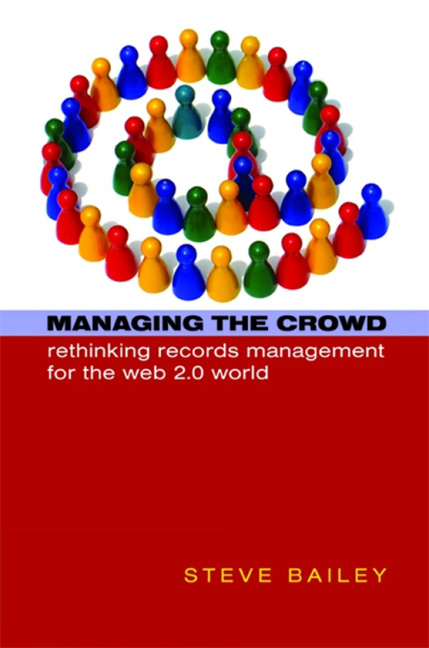Book contents
- Frontmatter
- Dedication
- Contents
- Foreword
- Preface
- Part 1 The Nature Of The Changing World
- Part 2 Is records management no longer fit for purpose?
- 5 The need for critical professional self-examination
- 6 ‘Not all information sources are records’
- 7 The centralized command and control ethos
- 8 ‘Regardless of format...’
- 9 Appraisal, retention and destruction
- 10 The problems with applying existing approaches to appraisal in the Web 2.0 world
- Part 3 Records Management.0 And The Future Of Records Management 121
- Index
7 - The centralized command and control ethos
from Part 2 - Is records management no longer fit for purpose?
Published online by Cambridge University Press: 08 June 2018
- Frontmatter
- Dedication
- Contents
- Foreword
- Preface
- Part 1 The Nature Of The Changing World
- Part 2 Is records management no longer fit for purpose?
- 5 The need for critical professional self-examination
- 6 ‘Not all information sources are records’
- 7 The centralized command and control ethos
- 8 ‘Regardless of format...’
- 9 Appraisal, retention and destruction
- 10 The problems with applying existing approaches to appraisal in the Web 2.0 world
- Part 3 Records Management.0 And The Future Of Records Management 121
- Index
Summary
Questions addressed in this chapter
• Why isn't records management scalable?
• Why are records management tools often too generalized to meet our users’ needs?
• What are the limitations of our existing approaches to resource discovery?
• Why is tagging more popular than adding metadata?
• Are we about to witness the decline of the general applicability of the classification scheme?
• If so, what can we replace it with?
Records management as a bottleneck
Records management, as traditionally practised, is not infinitely, nor even highly, scalable and this represents a significant barrier to its potential and influence. In fact, records management as a discipline is founded upon a very strong and entrenched ‘command and control’ ethos, largely stemming from the US corporate culture of the 1950s where it could be said that records management as a discipline was toughened and given added rigour. It assumes that decisions will be made at the centre by a small select group of people (or indeed a single person in the form of the records manager) and that these will then be applied, largely without question, by the general user base. This assumption is evident in just about every branch of records management theory and practice: from the formalization of a classification scheme and metadata schema, to decisions regarding which records should be destroyed and which retained.
This is not to say that the records manager acts as a dictator. If he or she is to stand any chance of success, it has long been recognized that such corporate standards must be arrived at in consultation with their user base. We have all experienced (perhaps from both sides) the finely honed new working practice that seemed to work brilliantly on the drawing board but quickly sank without trace when released into the real world because of a lack of consultation. The gulf between theory and practice can often be a large one. But even when changes are introduced after extensive consultation, much of our records management practice still acts as a significant bottleneck – and one that may prove unsustainable as we move into the Web 2.0 world.
- Type
- Chapter
- Information
- Managing the CrowdRethinking records management for the Web 2.0 world, pp. 67 - 80Publisher: FacetPrint publication year: 2008



